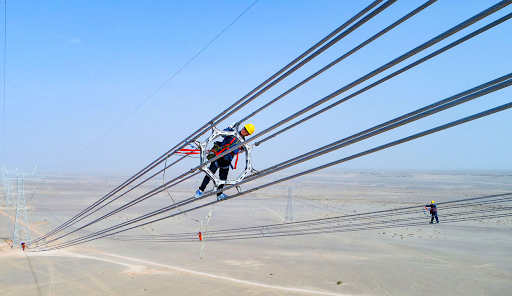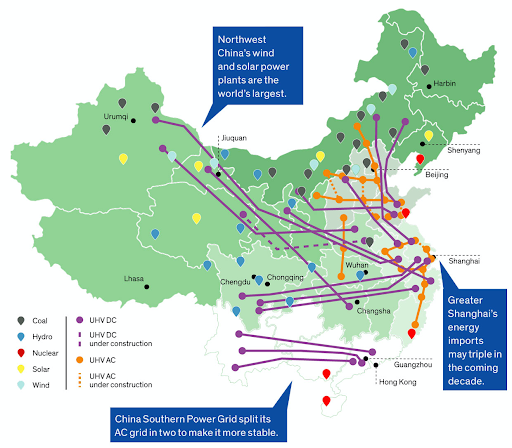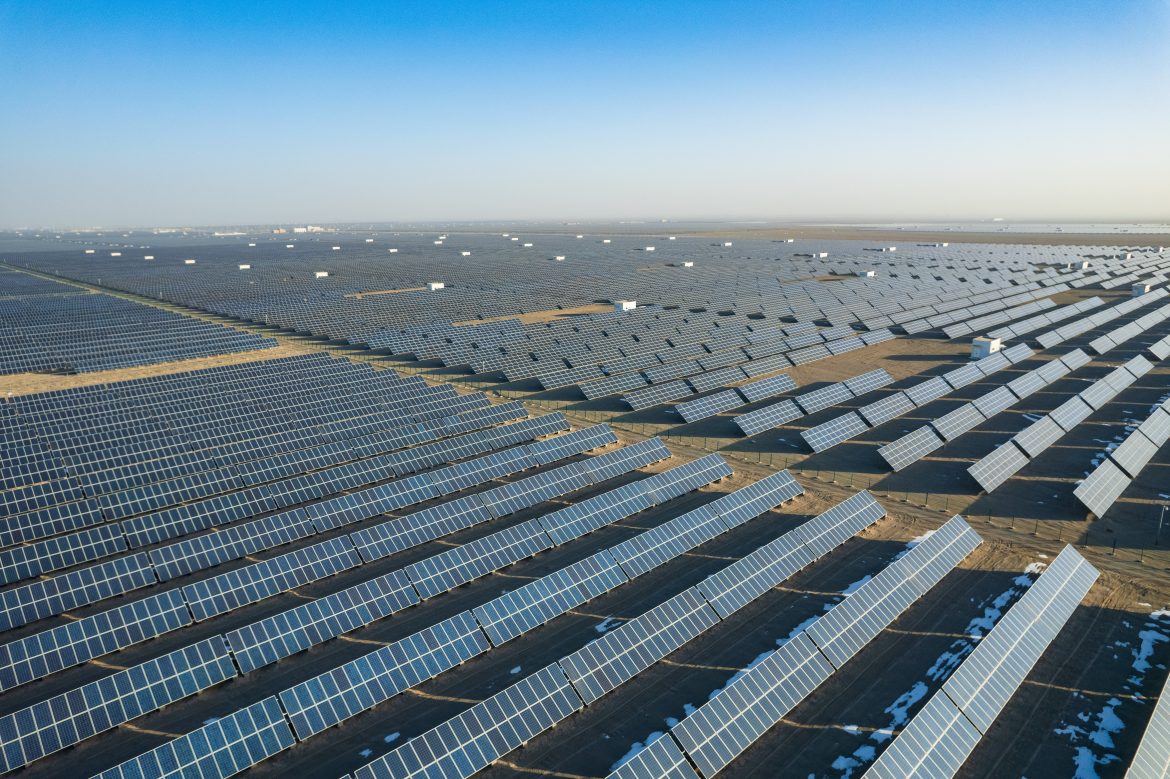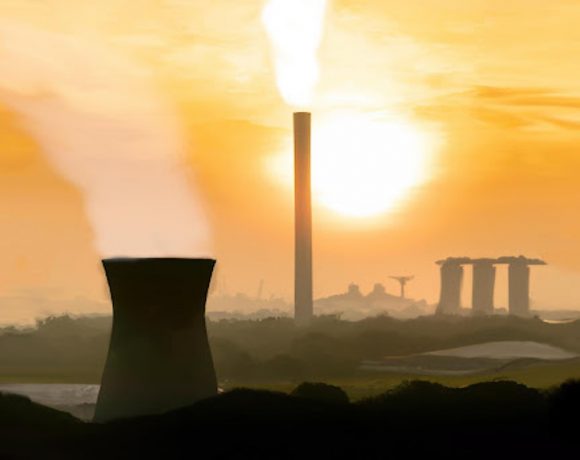- China is investing billions into building a nationwide “super grid” that employs massive, cross-country ultra-high voltage (UHV) power lines. The UHV technology offers the distinct advantage of being able to transfer high amounts of power over long distances at a very low current value, thereby minimising transmission line losses.
- China plans to combine long-haul UHV DC lines with a UHV AC backbone to help distribute the power to regional consumers. The network encompasses 31 lines, including the record-breaking 1,100 kV UHV DC Changji-Guquan link and is capable of transmitting a remarkable 12 GW of electricity over a distance of 3,293 km.
- Energy storage is seen as another vital component in enabling the large-scale application of renewable energy, as reflected by China’s first national policy document in 2017, which provided the impetus for energy storage to enter a new stage of large-scale development.
As China seeks to decarbonise its energy supply to meet its ambitious carbon neutrality goal by 2060, the country consistently emphasises the need to update its sprawling electricity grid so that it can reliably transmit power to where it is needed. Achieving this is no easy feat, however, as China has not only already established itself as the world’s largest energy consumer and producer but also continues to actively drive global energy growth. A recent BP report, for example, estimates that China accounted for a staggering 95% of net global electricity growth in 2019.
This is, in turn, compounded by two formidable challenges: first, having to transmit this considerable amount of energy, which is predominately generated in the vast, isolated regions of northwest China, to faraway consumers located in the densely populated megacities in the east, and second, having to integrate an increasingly large share of variable renewables into the energy system, without compromising stable operations.
Ultra-High Voltage Power Lines
To address these issues, the Chinese government has most prominently been investing billions into building a nationwide “super grid” that employs massive, cross-country ultra-high voltage (UHV) power lines. This is because, although expensive and arduous to erect, UHV technology offers the distinct advantage of being able to transfer high amounts of power over long distances at a very low current value, thereby minimising transmission line losses.

Record-Breaking Changji-Guquan Link (VCG/Getty Images, in: Fairley, 2019)
Spurred on by these promising advantages, the National Development and Reform Commission (NDRC) approved an ambitious plan in 2005 to build the world’s first UHV AC-DC power grid. The plan sought to combine long-haul UHV DC lines with a UHV AC backbone to help distribute the power to regional consumers. Today, China’s network encompasses 31 lines, including the record-breaking 1,100 kV UHV DC Changji-Guquan link, which was completed in 2018 with the help of Hitachi ABB Power Grids and is capable of transmitting a remarkable 12 GW of electricity over a distance of 3,293 km.

China’s UHV Grid (Erik Vrielink, in: Fairley, 2019)
Obstacles
Despite these advances, significant obstacles nevertheless remain, which have limited the construction of China’s UHV lines to less than half of the 89,000 km that had initially been scheduled to be completed by 2020. These have included complex coordination between several key parties, particularly the State Grid, the National Energy Administration (NEA), and local stakeholders, and a set of unique technological challenges, including the need to maintain significant emergency reserve power and the difficulty of sustaining the ideal voltage on the grid.
These obstacles are further impacted by China’s ambitious plan to increase its solar and wind power capacity to 1.2 TW by 2030 – compared to 535 GW at the end of 2020 – as these can fluctuate significantly with the weather, threatening grid stability. To circumvent this issue, existing UHV lines have generally bundled variable renewables with more stable energy sources, such as coal-fired thermal or hydropower, resulting in a relatively low share of solar and wind power in the energy mix.
However, thanks to the development of a new generation of UHV lines, which were designed to be able to handle the volatility of these energy sources, this ratio, as well as curtailment figures for renewables, is expected to improve in the near future. Initial examples of these new, purpose-built “green energy” lines include the Zhangbei-Xiong’an UHV AC line – China’s first UHV line designed to exclusively transmit energy generated by solar and wind – and the recently-completed Qinghai-Henan UHV DC line.

Qinghai-Henan UHV DC Line in left (SASAC, 2021). Zhumadian Converter Station in right (SASAC, 2021).
Energy Storage
Energy storage is seen as another vital component in enabling the large-scale application of renewable energy, as reflected by China’s first national policy document in 2017, which provided the impetus for energy storage to enter a new stage of large-scale development. Since then, China’s energy storage system has made significant progress, resulting in a total installed energy storage project capacity of approximately 33.4 GW by the end of 2020, the appearance of several new energy storage models, such as “sharing” and “leasing”, and a plethora of breakthroughs in a variety of energy storage technologies, including Li-ion batteries, vanadium flow batteries and compressed air energy storage.
Conclusion and Outlook
Spurred on by its ambitious climate goals, China will undoubtedly continue to invest heavily into the modernisation of its electricity grid. Former State Grid chairman Mao Weiming recently estimated that expenditures will likely exceed RMB 6 trillion (USD 930 billion) over the next five years. These funds will, in turn, not only help China to continue to foster cutting-edge research and innovation in fields such as UHV and energy storage, but also implement new hybrid solutions. Integrated renewables and storage – also known as “renewable energy + storage” – in particular has established itself as a leading trend in this context. 20 local governments and power grid enterprises have already put forward incentive policies and 33 “solar/wind + storage” projects have been announced in the first half of 2020.
Despite these developments, it is important to note that the economic viability of these models and technologies must be addressed to ensure long-term success. As underlined by the China Energy Research Society, “profitability is the key to sustainable development.”
References
Statistical Review of World Energy 2020. 2020, 69th ed. Available at: https://www.bp.com/content/ dam/bp/business-sites/en/global/corporate/pdfs/energy-economics/statistical-review/bp-stats-review-2020-full-report.pdf.
Energy Iceberg. Battery Storage Plus Renewable in China: the Inevitable Fate? [online]. 26.08.2020. https://energyiceberg.com/renewable-plus-battery-storage/ (accessed on 09.06.2021).
Energy Iceberg. China’s UHV Grid Construction: Leading but Not Enough? [online]. 27.01.2021. https://energyiceberg.com/china-uhv-review/ (accessed on 09.06.2021).
FAIRLEY, Peter. China’s Ambitious Plan to Build the World’s Biggest Supergrid [online]. 21.02.2019. https://spectrum.ieee.org/energy/the-smarter-grid/chinas-ambitious-plan-to-build-the-worlds-biggest-supergrid (accessed on 09.06.2021).
FISHMAN, David. “Cutting the Gordian Knot: China’s High-voltage Super Grid Evolves”. TLG on, 2021, p. 4. Available at: https://www.lantaugroup.com/file/tlgon_uhv_jan21.pdf.
Global Transmission. Focus on UHV AC: China shows the way by energising 1,000 kV line [online]. 02.03.2009. https://www.globaltransmission.info/archive.php?id=1434 (accessed on 09.06.2021).
Hitachi ABB Power Grids. The world’s most powerful transmission system facilitated by Hitachi ABB Power Grids technologies [online]. 13.07.2020. https://www.hitachiabb-powergrids.com/cn/en/news/global-news/web-stories/the-world-s-most-powerful-transmis-sion-system-facilitated-by-hi (accessed on 09.06.2021).
Ministry of Foreign Affairs of the People’s Republic of China. Statement by H.E. Xi Jinping President of the People’s Republic of China At the General Debate of the 75th Session of The United Nations General Assembly [online]. 22.09.2020. https://www.fmprc.gov.cn/mfa_eng/zxxx_662805/t1817098.shtml (accessed on 02.18.2021).
O’MEARA, Sarah. “China’s plan to cut coal and boost green growth”. Nature, 2020, 584, pp. S1-S3. Available at: https://www.nature.com/articles/d41586-020-02464-5.
RUOLIN, Ye and YE, Yuan. Untangling the Crossed Wires of China’s ‘Super Grid’ [online]. 09.03.2021. http://www.sixthtone.com/news/1006932/untangling-the-crossed-wires-of-chinas-super-grid?from=groupmessage&isappinstalled=0 (accessed on 09.06.2021)
SHI, Yubo. 2020 Energy Storage Industry Summary: A New Stage in Large-scale Development [online]. 01.03.2021. http://en.cnesa.org/latest-news/2021/2/28/2020-energy-storage-industry-summary-a-new-stage-in-large-scale-development (accessed on 09.06.2021).
State-owned Assets Supervision and Administration Commission of the State Council (SASAC). Qinghai-Henan UHV DC Project Put into Operation [online]. 01.07.2021. http://en.sasac.gov.cn/2021/01/07/c_6365.htm (accessed on 05.07.2021).
U.S. Energy Information Administration (EIA). CHINA [online]. 30.09.2020. https://www.eia.gov/international/analysis/country/CHN (accessed on 03.06.2021).
XU, Muyu and GEDDIE, John. Analysis: To tackle climate change, China must overhaul its vast power grid [online]. 19.05.2021. https://www.reuters.com/business/environment/tackle-climate-change-china-must-overhaul-its-vast-power-grid-2021-05-19/ (accessed on 09.06.2021).






NO COMMENT